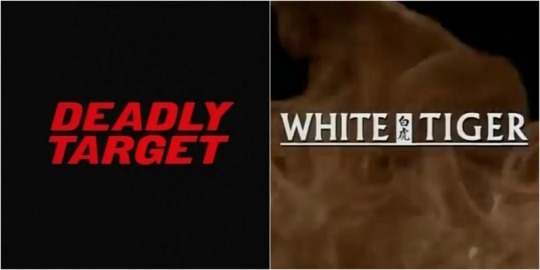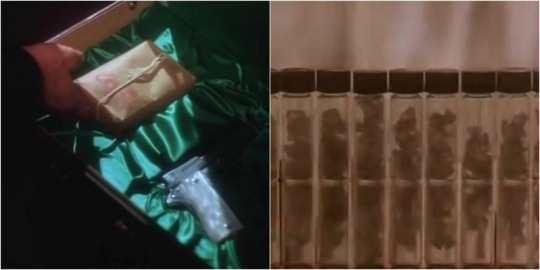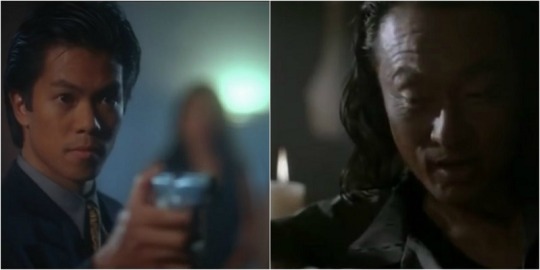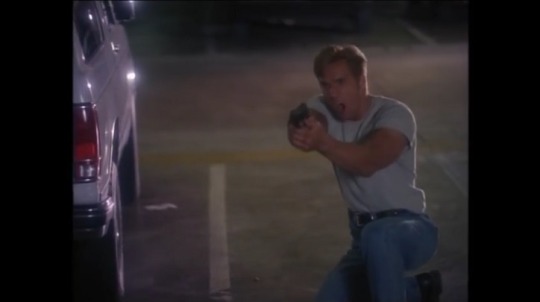#ended up drawing ship art and now b barney....
Text
Film Face-Off: Deadly Target (1994) Vs. White Tiger (1996)
While re-watching some of my movies in search of something to review, I realized how strikingly similar 1994’s Deadly Target and 1996’s White Tiger appear to be. Both are pretty good vehicles from Gary Daniels’ solo career, and seemingly by coincidence, they have the same plot. This realization and the provisional quality of the films makes me want to try something new and turn this would-be review into a competitive comparison between the two. Should be fun, right?
Know now that this article’s almost exclusively for the Gary Daniels fans out there. Few casual viewers will have seen both features, but hey, we’re all about niches here at B-Movie Dragons.

First, some background. Deadly Target is a PM Entertainment production, and while not the first starring picture for Gary Daniels, it’s his first solo vehicle that’s actually good. Indeed, it wasn’t until PM gave him this nudge that the prettyboy kickboxer from London became Gary friggin’ Daniels. Just a couple years afterwards, he was working on a Hong Kong feature when the production went broke and was bought out by the Canada-based Keystone Pictures company. Keystone scrapped the existing footage and did away with the storyline, committing themselves to a completely different movie called White Tiger, which inexplicably ended up being very similar to Daniels’ aforementioned feature. There’s no evidence that this was actually their intention, but there’s no denying the parallels.
Now, let’s look at which version of this adventure did it better.
The Story

In both features, a law enforcement agent seeks to capture a rogue member of the Chinese-American mafia who’s killed the hero’s partner en route to distributing an addictive narcotic on the West Coast. In both cases, the hero is aided by a love interest and the final showdown takes place on a docked ship.
The overriding difference between the two is how seriously the story takes itself. As tends to be the case with PM productions, Deadly Target is lighthearted with a noticeable comedic streak. It’s a popcorn flick despite never having seen the inside of a theater. Contrarily, White Tiger is far too serious to have much fun with itself. It goes for drama over laughs, and even when there is some humor, it’s dry or ironic. Merely considering this, I prefer the former. While I can see some viewers being bored by Deadly Target’s 90s-style cheesiness, it’s the same cheese which gives the story texture and an organic quality that White Tiger lacks.
That said, White Tiger invests you more in its characters. While not the most skillfully-written action feature, it knows what it’s going for and does a good job of directing viewers’ emotions. Deadly Target’s characters are established as soon as they appear onscreen, but White Tiger’s tend to not show their cards right away. There’s development here, and it’s not just limited to the leads. The movie wants you to think about characters’ motivations, and it’s ambitious enough to try and surprise the audience at intervals with out-of-nowhere twists. Wisely, it doesn’t overplay its hand: though it liberally sprinkles the thriller aspects, it never forgets that we’re expecting an action movie and makes sure to avoid pretentiousness. To that end, it wins me over. Deadly Target may be more fun, but White Tiger gives me more to write about. It’s a pretty good movie with which to introduce newcomers to Gary Daniels, whereas Deadly Target is mainly for established B-movie audiences.
Point: White Tiger
The Hero

Gary Daniels wasn’t the greatest actor at this point in his career and his starring roles sort of blend together. Such is the case when you compare these movies: he’s Detective Charles Prince in Deadly Target and Agent Mike Ryan in White Tiger, and they seem like merely different takes on the same character. The major difference between them is that Charles seems to have more fun with his life-or-death mission, taking the time to crack jokes and express interest in other things while Mike pursues his target with uniform intensity. You can see practically Charles in an early scene of White Tiger while the hero’s vacationing with his partner’s family, and Mike seems to pop up in Deadly Target whenever he’s faced with the lead villain.
When it comes to their motivations, Mike is a little easier to empathize with. Charles mentions that the villain killed his (first) partner, but with Mike, you not only see this happen but also experience his investment in his partner’s family. This favors White Tiger, and it doesn’t help that Charles seems to have some sort of unspoken homophobia going on…but despite that, I give the point to Deadly Target. For all his shallowness, Charles is simply more likable. Gary Daniels turns in a better dramatic performance for Mike, but he’s just not interesting enough to make his relentless seriousness worthwhile. Charles is an example of Daniels having fun with a role, and in this case, it wins him the category.
Point: Deadly Target
The Villain

A hero is only as impressive as their adversary, and in both cases, Gary Daniels draws a good card for a bad guy: Byron Mann as Chang in Deadly Target and Cary Hiroyuki-Tagawa as Victor Wong in White Tiger. Mann and Tagawa are both acclaimed performers who, despite having predominantly acted in other genres, are generally known for playing martial artists – Mann in Street Fighter: The Movie and Tagawa in Mortal Kombat. Both are versatile actors who swing between low-budget and Hollywood-grade productions with ease, bringing class to both while keeping their dignity intact. For both movies, they elevate the production and help legitimize Gary Daniels with their presence.
That said, I’m more impressed by Cary in this instance. Part of it’s just that his character’s written with greater nuance, but he also just has the stronger presence. It helps that this role goes against type for him, so that he’s not depicting an upright sentinel for a change. He starts off like that, but within minutes you get the impression that Victor Wong would be more at home in The Silence of the Lambs than Showdown in Little Tokyo. By the time the movie reaches its climax, Victor has become a self-destructive freak, single-handedly justifying the film’s drug & fire motif. Comparatively, Mann doesn’t have much going for him other than that he’s obviously having fun. Byron manifests the tone of the screenplay perfectly, but his character sometimes goes absent long enough for me to almost forget he’s the bad guy. Given his youth, Mann may seem like the more obvious choice for an underworld renegade who’s upsetting the established order, but Tagawa stands out thanks to Victor’s greater depth. (Also, he has a fight scene with Gary Daniels, which Mann doesn’t.)
Point: White Tiger
The Love Interest

Please forgive the condescension this label implies, but in both movies, the most prominent female character is largely defined by her relationship with the hero. Nevertheless, Susan Byun’s Diana Tang and Julia Nickson’s Jade are uniquely different characters that lend differing tones to their features. Diana is a warm-hearted person who, despite working in a casino owned by a mob boss, leads a pretty sheltered life. Jade spends much of her movie being an enigma, clearly knowing more than she’s letting on. Diana wants to get intimate with Charles because she feels genuinely attracted to him, whereas Jade is a femme fatale who nudges Mike along and has sex with him only to further a personal agenda. Also, Jade is infinitely more in touch with her Hong Kong heritage while Diana is utterly Americanized and initially repulsed when Charles prepares her a “Chinese delicacy” with squid.
As for who earns the point, it comes down to how they fare in the face of danger, and there’s really no question. Diana introduces herself by clubbing an attacker in the head to rescue Charles and later goes on to have two unexpected fight scenes. Susan Byun becomes a temporary action hero despite her character’s conventions, but Julia Nickson ironically fares worse. White Tiger spends much time building Jade up as an experienced assassin, but when the need for her to make a move arises, she’s instantly overwhelmed and becomes a damsel without really having accomplished anything. For both of these characters, they end up doing the exact opposite of what you’d expect, but only Diana benefits from it. It’s a cheap move on the part of White Tiger’s writers to ultimately demean their character this way, and in this instance, it costs them.
Point: Deadly Target
The Supporting Cast

Which set of supporting characters you end up preferring is largely dependent on what tone you favor, as all the performers do a good job reflecting the mood of their picture. Again, there are many parallel roles that are merely played differently. Portraying the hero’s partner is Ken McLeod in Deadly Target and Matt Craven in White Tiger: martial arts-practicing straight man and tragic best buddy. Both police captains are played by award-winning TV actors: colic-y Max Gail (Barney Miller) and the reserved Philip Granger (Neon Rider). The most visible mafia lord is played by the expressive Aki Aleong in the first film and the graceful Dana Lee in the other. Both feature henchman extraordinaire Ron Yuan as the villain’s lieutenant, but he’s only a fully-fledged character in Deadly Target. Last but not least are the roles good ol’ George Cheung plays: he’s a mafia figure with no lines in the first picture, and one of the more interesting co-stars in the second.
If there was nothing else to consider, I’d happily decree this category a draw, but the deciding factor ends up being the amplitude of supporting fighters in Deadly Target. It’s a cool lineup: Leo Lee, Al Leong, James Lew, Randall Shiro Ideishi, and Koichi Sakamoto all have at least one highlighted altercation, and the late Master Bill Ryusaki plays one of the more active henchmen. Lieutenant Lydia Look – along with her stunt double, Olympian taekwondoka Dana Hee – has a couple of surprisingly good fights against Susan Byun. By comparison, White Tiger doesn’t bother highlighting many of its supporting kickers, and that seals it for me.
Point: Deadly Target
The Production

In addition to the filmmakers’ talent, the quality of a movie’s production is a matter of time and budget, and it’s easy to tell which of these films had more. As I’ve mentioned, Deadly Target is a PM Entertainment film, and while PM was great at maximizing its resources and cranking out exciting B-movies, it’s obvious that these are, in fact, B-movies. Deadly Target’s no exception: the locations are unremarkably urban, the cinematography is staid, the camerawork isn’t dynamic, and even the film quality is a little grainy. Director Charla Driver – one of the few women to direct a PM production and one of the few women to direct a U.S. martial arts feature, period – is every bit as good as her cohorts at putting together a compact and entertaining action package, but there’s no opportunity for it to rise above that status.
White Tiger, on the other hand, may easily be mistaken for a Hollywood production. Keystone Pictures would actually produce a couple of those shortly after this one, which in retrospect seems like a warm-up exercise for director Richard Martin. The movie showcases some exotic locations, has a lot of good-looking sets, and actually has the time to do fun stuff with its camera. The musical stings are almost comically overdone at times, but the soundtrack still stands out where its adversary’s is forgettable. The movie generates mixed results when trying to be artsy but still has the finesse to qualify as a neo-noir. Whereas both features are by-the-numbers in their own way, White Tiger is simply more lavish and thereby pulls ahead.
Point: White Tiger
The Action

In a way, this is the most important category. Action pieces and fight scenes are the backbone of any martial arts feature, and with a star as capable as Gary “Danger Man” Daniels in the lead, both productions knew they had the potential to make a minor action classic. To help get them there, both selected fantastic coordinators to get the job done: Deadly Target had Jeff Pruitt and White Tiger had the late, great Marc Akerstream.
Pruitt was an exotic regular of the TV and DTV realms from 1991 to 2003. As the first American member of the Japan-based Alpha Stunts team, his cohorts and he brought a dynamic, stunt-heavy style of action to the small screen. Though best known for working on Mighty Morphin Power Rangers, Jeff regularly got career-defining performances out of the performers he directed, particularly DTV golden boy Jeff Wincott. Deadly Target was the first (and thus far only) time Pruitt collaborated with Gary Daniels, and the Hong Kong veteran works well with the style of his handler. No slouch either is Akerstream, whose career highlight may have been working with Jackie Chan by coordinating the vehicle that gained JC fame in America: Rumble in the Bronx. Though he tended to work in low-budget fare, he coordinated several times in Hollywood blockbusters and did a ton of work for TV. Tragically, an accident on the set of The Crow: Stairway to Heaven ended his life in 1998.
White Tiger may actually be Marc’s magnum opus as an action filmmaker, as he delivers some strong pieces without being relegated by a higher-placed coordinator. Though this is primarily a martial arts movie, it mixes things up with some vehicle scenes and shootouts. Deadly Target does this as well, but White Tiger has a flair in that regard that the former can’t top, especially when it comes to the well-choreographed scenes with the biker assassins. Still, Gary Daniels’ fight scenes are the highlights of the picture, and what highlights they are! The brawls dig deep into Daniels’ real-life abilities, featuring not only a plethora of spinning kicks but also aikido throws and intricate kung fu exchanges. A showdown with Ron Yuan is pretty cool, and the final match with Cary Hiroyuki-Tagawa is a very decent brawl.
However, the increased production standards ultimately work against White Tiger via over-editing. While not horrible, the fight scenes are filled with cuts and slow motion that tries to fool you into thinking that the brawls are even better than they already are. Gary Daniels isn’t some inexperienced Ken doll with shortcomings that need disguising, so the editing tricks are facetious. Deadly Target’s fights have no such problems, with their long takes and limited slow motion. Though Jeff Pruitt’s heavy usage of throws and flips may seem excessive to some, the fact is that his film’s simply less restrained in showcasing physicality. While I understand that White Tiger’s action may simply be a matter of stylistic consistency, Deadly Target’s greater willingness to show a fight junkie like me everything its performers have to offer puts it over its competition.
Point: Deadly Target
The Winner: Deadly Target

Deadly Target (1994)
Directed by Charla Driver (assistant director for Ice Cream Man)
Written by James Adelstein, Michael January (To Be the Best)
Starring Gary Daniels, Susan Byun (Sgt. Kabukiman N.Y.P.D.), Ken McLeod (College Kickboxers), Byron Mann
Cool costars: Ron Yuan, Aki Aleong (Farewell to the King), Lydia Look (Battle of the Damned), Philip Tan (Martial Law), Master Bill Ryusaki (Ulterior Motives), George Cheung (First Blood II), Al Leong (Rapid Fire), Leo Lee (The Perfect Weapon), James Lew (Balance of Power), Randall Shiro Ideishi (Black Scorpion), Koichi Sakamoto (Bounty Tracker), Butch Togisala (Firepower)
Content warning: Violence against women, kidnapping, police brutality
Copyright PM Entertainment Group / Echo Bridge Home Entertainment
White Tiger (1996)
Directed by Richard Martin (Air Bud: Golden Receiver)
Written by Bey Logan (original story), Gordon Melbourne (Bulletproof Heart), Roy Sallows, Don Woodman, Raul Inglis (uncredited)
Starring Gary Daniels, Cary Hiroyuki-Tagawa, Julia Nickson (Noble House), Matt Craven (Crimson Tide)
Cool costars: Ron Yuan, George Cheung, Dana Lee (Dr. Ken)
Content warning: Violence against women, torture, sexual assault
Copyright Keystone Pictures / Crown Media
#film review#film criticism#deadly target#white tiger#gary daniels#martial arts film#susan byun#ken mcleod#byron mann#Cary Hiroyuki Tagawa#julia nickson#matt craven
6 notes
·
View notes